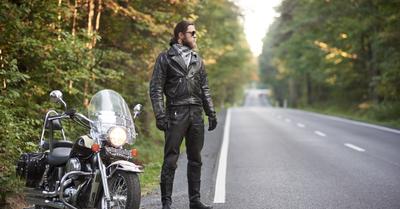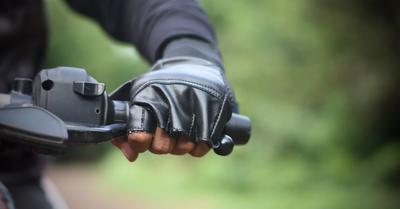2023 Kawasaki Ninja 400
Debuting in 2018, the Ninja 400 replaced the venerable Ninja 300 as the smallest displacement bike in the Ninja lineup. It is a parallel-twin entry-level sport bike with features that punch well above its weight.
The Ninja 400 has not undergone any major redesign since its inception in 2018. The 2023 model features four available colors configured with or without ABS.
Boasting 44hp and 28lb-ft of torque, the Ninja 400 consistently ranks at the top of best-of lists for small-displacement sport bikes and overall entry-level bikes. With a comfortable seat height of 30.9-inches, the Ninja is an excellent bike for riders of all sizes.
Many reviewers have praised the Ninja 400, citing a fun-to-ride but approachable power level. Further reviews of the bike applaud its value on a power-to-cost basis, calling the 399cc engine just the right size for those new and old to the hobby.
The 2023 model is available in two primary configurations, ABS-equipped, and non-ABS. Both arrangements feature the same 399cc DOHC liquid-cooled parallel-twin engine. They also have an electronic fuel injection, a six-speed transmission, and an assist and slipper clutch. The inclusion of ABS bumps the weight up 4.4lbs from 361.6lbs for the non-ABS to 366lbs for the ABS-equipped model.
In addition to choosing between ABS or non-ABS, the 2023 Ninja is available in four colorways. The Ninja comes standard dressed in Matrix Camo Gray and Metallic Matte Carbon Grey at no additional charge.
For $200, you can upgrade to either Pearl Blizzard White and Metallic Carbon Gray or Metallic Magnetic Dark Gray and Metallic Matte Twilight Blue. The bike is also available as the Ninja 400 KRT Edition fitted in Kawaski Racing Team livery for the same increased cost.
Cost
Looking at Kawasaki’s website, the 2023 Ninja 400 is listed with multiple MSRPs. Beginning at $5,299 and extending to $5,899, it can be confusing what all is different across that $600 spread.
The lowest-priced Ninja coming in at $5,299, is for the non-ABS configuration with the standard black-on-gray coloring. The non-ABS bike’s cost increases by $200 to $5,499 if you opt for either the blue and gray or the white and gray colors. The 2023 Ninja 400 KRT edition is also available for $5,499, which is the same bike but with a green, black, and red design.
The ABS-equipped Ninja sees a price bump of $400. The same colors are available, with the standard black affair running $5,699 and the other three colors pushing the bike’s MSRP up to $5,899.
However, MSRP is not the only cost to consider when looking to buy a new Ninja. In addition to MSRP, there are destination charges of $435 and freight charges of $300, which bump the bike's total cost by $735 regardless of which configuration you choose. In small print, Kawasaki does point out that the dealers set the actual destination charge, so your total cost may be higher.
Factoring in the standard additional charges of $735, we now see the cost of a 2023 Ninja 400 jump to between $6,034 and $6,634. Depending on where you are there are also usually taxes and documentation fees you must pay when you purchase your motorcycle. With all these additional costs tacked on it is possible that your new Ninja 400 may end up costing more than $7,000 out the door.
So if you are budgeting for your new bike, please keep these additional costs in mind. It never hurts to negotiate with the dealership or shop around. I live in the Pacific Northwest, and it is not uncommon to see bikes listed significantly cheaper one state over from me.
ABS vs. Non-ABS
With the main cost difference stemming from the bike being offered with or without ABS, it is essential to know what ABS is when considering which bike is right for you.
ABS stands for Antilock Braking System and does what it sounds like. It is a system designed to stop the brakes on your bike from locking up by modulating the pressure applied from the calipers to the rotors. With reaction times much faster than human reflexes, modern ABS modules can measure braking forces up to 100 times per second and dynamically adjust the braking pressure up to 10 times per second.
Anyone with some time in the saddle of a motorcycle will tell you that locking the brakes on your bike can spell disaster. Locking the brakes happens from braking too harshly or suddenly, such as for an unexpected obstruction in the road or someone pulling out in front of you. When the brakes on your bike lock, the wheel loses traction, and your motorcycle begins to skid.
ABS has more-or-less been a standard feature on cars and trucks for a long while now. So it makes sense that we have also begun to see this technology implemented in motorcycles. However, ABS has been a point of contention for some motorcyclists. There are claims that the inclusion of ABS increases costs too much or that ABS-equipped bikes weigh significantly more than their non-ABS counterparts.
For the Kawasaki Ninja 400, the inclusion of ABS raises the cost by $400, increasing the base MSRP of $5,299 to $5,699. That price bump is an increase of only 7.5%. ABS also brings the weight of the bike up 4.4lbs from 361.6lbs to 366lbs, a 1.2% weight increase.
The Insurance Institute for Highway Safety (IIHS) has published a study regarding fatal motorcycle crashes. Examining the fatal crash rates of 65 different motorcycle models that offer ABS, the IIHS has found that ABS-equipped bikes were involved in 22% fewer fatal accidents than their non-ABS counterparts.
I believe that the modest increase in price and the negligible increase in weight are worth it for the ABS-equipped Ninja 400. Especially as a starter bike for new riders, the inclusion of ABS is more forgiving and can reduce accidents.















